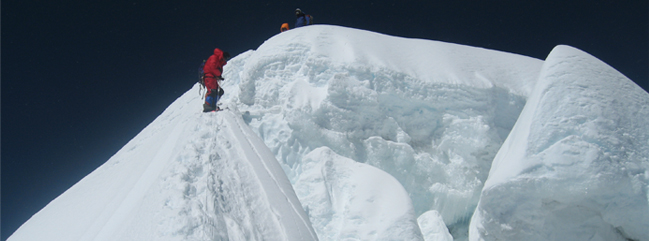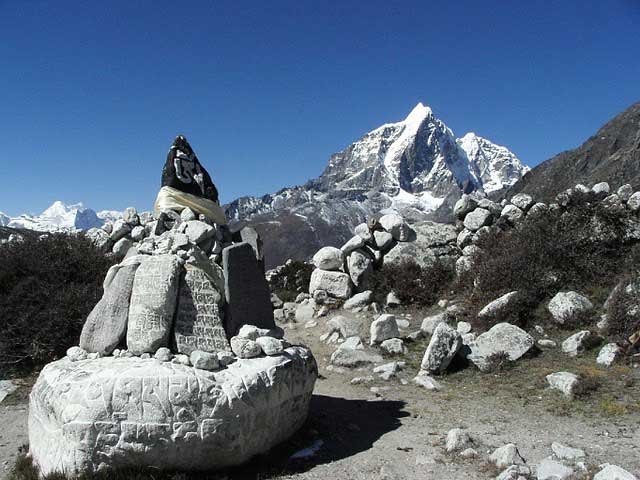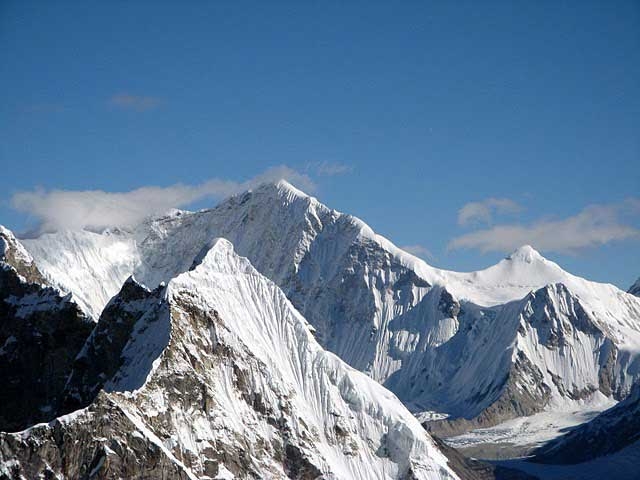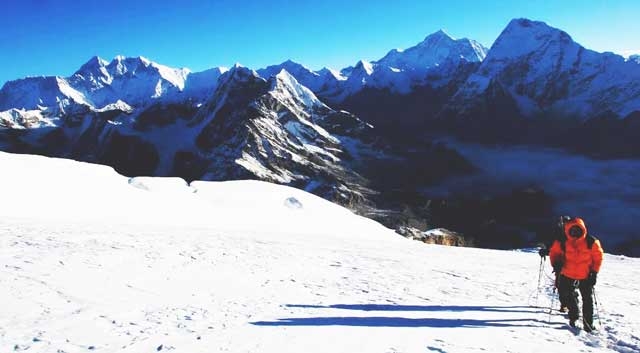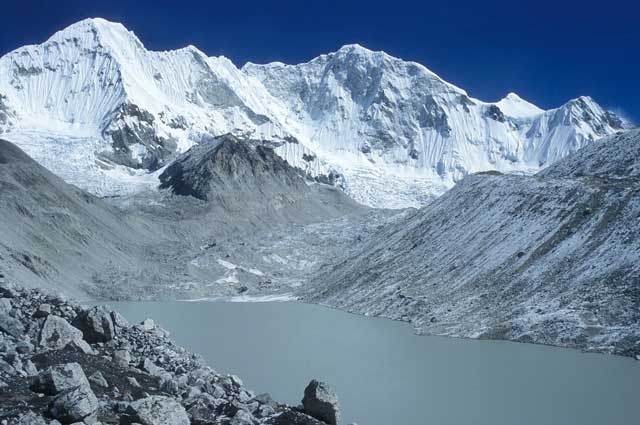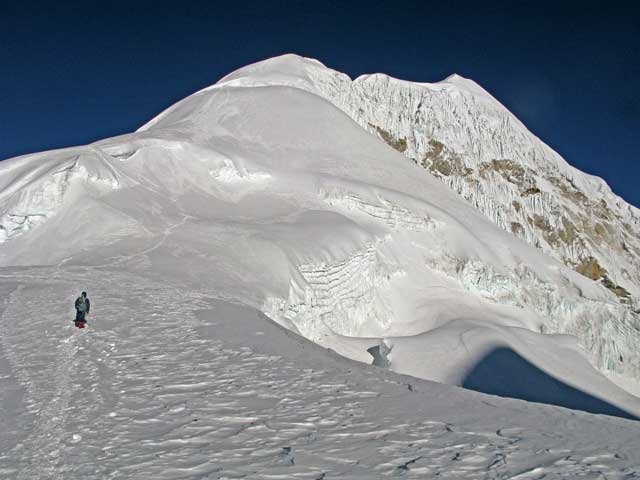Among the hundreds of peaks of the world, Baruntse 23,390 ft / 7129m is one of the most gorgeous peaks which lies at the center of three glacier valleys, the Imja, the Hunku and Barun. The peak itself commands a central position amongst some of the high peaks of the Himalaya. The rewards of summit day include spectacular views of Lhotse, Everest, and Makalu. The first ascent of Baruntse was made by Colin Todd and Geoff Harrow on 30 May 1954. They ascended the mountain by the South-East Ridge, which will be the line of our ascent.
We strongly recommend you to book this trip as this one of the best practices for the climber who desires to climb Mt Everest and any other 8000 meters peaks. The successful climb of Baruntse peak provides maximum chances of success to climbing Mt Everest as the trails and topography are similar each other. Join us and climb Baruntse, we can change your dream of climbing Everest into reality. We believe; once you trust us, trust forever.
The completion of this expedition on the top of Baruntse including Kathmandu tour, trekking, Mera peak climb takes 40 days. The trail to base camp takes 14 days from the fertile green of the Arun Valley, through the terraced farm land and spring crops to the barren mountainous realm of Makalu, the northern neighbor. Two camps are set up above base camp for climbing. The camp I is set up just below East Col. at an altitude of 5,700m and the Baruntse camp II is on the South – East Ridge at a altitude of 6,420m.
This trip starts from Kathmandu and ends in Kathmandu. It will be guided by our fully experienced Sherpa climbing guide. The indigenous Shepras were born in the Himalayas, grew up in the Himalayas. Its home for them, it’s in their blood. They’re not only ‘familiar’ with local communities and culture; they’re a part of them and they practice it. They truly love their home and relish getting the opportunity to show travelers.
Day 01- Arrival in Kathmandu airport (1345meters).
There you will be met by our Airport Representative and transferred to hotel by private tourist vehicle. Overnight at hotel.
Day 02- Pre-trip Meeting and Sightseeing around Kathmandu valley.
In the morning after breakfast at 9 AM, we host a Pre-Trip meeting at your hotel in Kathmandu and introduced your trek Leader/Guide mean time and it will provide an opportunity for individuals to ask questions about the your trek and to introduce you to other participants. This includes a final briefing and preparations for the trip.
PLEASE ADVISE US IF YOU WILL BE ARRIVING LATE AND ARE THEREFORE UNABLE TO ATTEND THE PRE-TRIP MEETING.
In THE PRE-TRIP MEETING All passengers MUST bring:
1. Passport.
2. Four copies of Passport size photos each.
3. Travel Insurance Policy.
4. Notepad/ pen
After the Pre-Trip meeting and breakfast your sightseeing trip will start at 9.45 AM in the morning for both days. We provide a private vehicle and professional tour guide. The places we visit are as below:
Pashupatinath
Situated 5 kilometers east of Kathmandu city, Pashupatinath temple is considered one of the holiest Hindu temples dedicated to Lord Shiva. Situated amidst a lush green natural setting on the banks of the Bagmati River, the temple built in pagoda style has gilted roof and richly carved silver doors. Visitors are permitted to view the temple from the east bank of river Bagmati as entrance into the temple is strictly prohibited to all non Hindus. Pashupatinath is the center of annual pilgrimage on the day of the Shivaratri festival which happens around February/March. Behind the temple are the cremation grounds.
Boudhanath
This Stupa situated about 8 kms from Kathmandu City is one of the biggest of its kind in the world. Standing with a pair of eyes in each of the four directions, it symbolizes watchfulness. It is said that this Buddhist Stupa was built by King Man Deva at the advice of the goddess Mani Jogini. It rises from an octagonal base inset with prayer wheels. The shrine is surrounded by houses of Lamas or Buddhist priests. The Stupa is surrounded by a lot of monasteries.
Bhaktapur Durbar Square
As you walk in, you will feel a sense of inner harmony. Bhaktapur Durbar Square is a collection of pagoda and shikhara – style temples grouped around a fifty-five-window palace of brick and wood. The attraction of the Bhaktapur Durbar Square is The Lion gate, The Golden gate, The Palace of fifty-five windows, Art Galleries, The Statue of King Bhupatindra Malla.
Day 03- Official formalities and Preparation day in Kathmandu. Overnight at hotel.
Formal briefing in the Ministry of Tourism. Today, the expedition leader will also check everyone’s equipment.
Day 04- Final Preparation day in Kathmandu. Overnight at hotel.
The last opportunity to buy anything missing.
Day 05- Fly to Lukla (2804 meters) trek to Chutok (2800 meters) 3 hours.
An early morning start takes us to Tribhuwan international Airport in Kathmandu for the 35 minute scenic flight to Tenzing and Hillary Airport at Lukla at 2804meters. On arrival at the airport our guide will brief you and introduce our porters before we begin our trek towards up to the Chutok La pass at 2945meters and over night at Chutok at elevation of 2800meters. Overnight at tented camp.
Day 06- Trek – Col Khari La (3081 meters) to Pangkongma (2950 meters) 6 hours.
After the pass of Col Khari La the trail carries along mountain sides through the Khari Khola valley to set up camp in Pangkongma. Overnight at tented camp.
Day 07- Trek to Kurke (3800meters) 5 hours.
A magnificent route via mountain crests through rocky and wild landscapes. Passing through and enjoying the splendid panorama of wooded regions below us. Overnight at tented camp.
Day 08- Trek to Thuli Kharka (4200meters) 6 hours.
Today we climb up to a pass at 4400meters and descend towards Thuli Karkha, which mean “vast pasture”. Overnight at tented camp.
Day 09- Trek to Khothey (3600 meters) 5 hours.
We descend on hillsides, by pleasant meadows and lower down through forests of blue Himalayan pines and rhododendrons. Beautiful views of the south side of Mera Peak. Overnight at tented camp.
Day 10- Trek to Tangnag (4350meters) 6 hours.
We climb up the Hinku valley through summer pastures, near Lungsamba the valley narrows wedged between the Kusum Kangru 6369 meters and the west summit of Mera Peak 6255 meters. Overnight at tented camp.
Day 11- Acclimatization and Rest day at Tangnag.
Spending a day here in order to acclimatize and adjust to the thinning of the air. Overnight at tented camp.
Day 12- Trek to Khare (4900meters) 4 hours.
Climb up along the lateral moraine of the Dig Glacier, providing interesting views of the Mera Peak. Overnight at tented camp.
Day 13- Trek to Mera La (5415meters) and Base Camp (5300m) 5 hours.
Progressing along the snowy glacier, we approach the pass the slope becomes steep. Overnight at tented camp.
Day 14- Climb Base Camp to High Camp (5800meters) 5 hours.
One of the best parts of the trek. Stunning panoramas of giant mountains rising above 7000meters, among the highest on earth: Chamlang (7290meters), Makalu (8475meters) and Baruntse (7220meters) to the east, Everest (8848meters), Lhotse (8501meters) and Nuptse to the north. Continuing westward the peaks of Ama Dablam, Cho Oyo (8153meters) and Kantega fill our view. Overnight at tented camp.
Day 15- Summit to Mera peak (6654meters) and then return to the Mera peak base camp.
Start early in the morning depending on the weather condition. Overnight at tented camp.
Day 16- Trek to Khare. Overnight at tented camp.
Climb down along the lateral moraine of the Dig Glacier, providing interesting views of the Mera Peak. Overnight at tented camp.
Day 17- Trek to Baruntse Base Camp.Over night at tented camp.
This day leads us towards the starting point of our prime destination which takes about 7 hours. We spend our night at tented camp.
Day 18- Rest and acclimatization day in Baruntse base camp.
This is very important day for climbing purpose. On this day you will have more rest which makes you physically and mentally ready for your Climbing mission. We spend our night at tented camp.
Day 19 to 31- Climbing Period
As we are physically and mentally ready, we start our climb. This climb doesn’t look so difficult as we have already climbed the Mera peak 6654 meters. To make our climb successful, we establish 2 camps above Baruntse Base Camp. Two camps are set up above base camp for climbing. The camp I is set up just below East Col. at an altitude of 5,700m and the Baruntse camp II is on the South – East Ridge at a altitude of 6,420m.
Above C1, we climb 50° snow slopes past a subsidiary summit at 6,745m from where the route becomes more involved. A series of short, steep steps of snow and ice are gained until we pass onto the west side of the ridge. Some short sections of rock scrambling lead back onto the ridge until it narrows at about 7,000m. This leads to a marked cleft and an ice cliff, which is surmounted to give access to easier, broader slopes above. These lead to the summit at 7,129m. which takes approximately 10 hours. After we kiss on the top of Baruntse, we descent through the same route.
Day 32- Rest and cleanliness program in Baruntse base camp.
It is true that base camp was our home for several days from where you attempted your climb which might be a bit dirty due to the garbage. Thus this is the day where we clean the surroundings of the base camp area as this is a very important part of responsible eco tourism. And rest of the days we will spend resting over there seeing the spectacular views of the Himalayas.
Day 33- Trek back to Seto Pokhari camp. Overnight at tented camp
We walk in a balanced way as we have climbed the two important and challenging peaks which are the often target of most of the world’s climbers. Thus we spend our overnight at tented camp in Seto Pokhari camp.
Day 34- Trek to Mera Peak Base Camp. Overnight at tented camp.
Day 35- Trek to Khothey (3600 meters). 6 hours.
Leaving the mountains behind us our descent takes us through Tangnag before continuing back to Khothey 3600meters. Overnight at tented camp.
Day 36- Trek to Thuli Kharka(4200 meters) 6 hours.
Our trek Descends back the same way. overnight at tented camp.
Day 37- Trek to Lukla (2804 meters) 7 hours.
Finally we return to Lukla where the trek began, which will seem like a lifetime ago. Enjoying time to reflect on the trek as a group and the personal achievement of all those who took part. Also giving you time to explore the town. Overnight at tented camp.
Day 38- Thirty five minutes flight to Kathmandu from Lukla early in the morning.
Enjoying your last glimpse of the mountains you have recently visited for one last time on the 35 minute Scenic flight back to Kathmandu. On arrival in Kathmandu we are met and transferred back to our starting hotel. Overnight at hotel.
Day 39- Leisure day in Kathmandu.
This is also a buffer day in case our Lukla flight is delayed. If we fly out of Lukla on time we have a full day to relax and enjoy the various delights of Kathmandu. Ace the Himalaya will host an evening barbecue to celebrate the expedition and as a farewell party to thank the Sherpas and the team member for their support and friendship during the expedition with the hope of seeing you all again for next expedition, hopefully Everest!!!
Day 40- Transfer to international airport for your final flight departure.
The trip ends, our Airport Representative will drop you to the Kathmandu international airport for your flight departure from Nepal.
PLEASE NOTE: The above itinerary is not a fixed program but is intended to give an indication of the likely events during the expedition. Please note that because of climbing Baruntse it will be necessary to have a flexible plan in order to take the best advantage of situations as they present themselves. Any changes to the itinerary will be made with a view to maximizing the benefit to the team members and of ensuring their eventual success on the mountain.
Normally climbers will change their departure flights from Kathmandu when they know exactly when the expedition is going to end. We plan to stay at Base Camp for longer period of time, or as long as it takes for us to be successful.
Team members should take out private insurance if they wish to be covered against cancellation due to medical or personal reasons. This is called trip Cancellation insurance and can be obtained from your normal travel agent.
Our Philosophy
Our aim is to safely help as many team members as possible reach their goal, and we invest in the people and equipment that will make this happen. We value our reputation as the premiere climbing company in Himalayas and we only put programs in place that measure up to our own high standards. If you would like to join an excellent team on Baruntse, we encourage you to contact us to discuss your goals and qualifications and secure an exciting role for yourself on our team.
Medical Cover
All of our local leaders are trained in first aid and have a good knowledge of high altitude medical problems. The expedition will be equipped with the following:
-A well stocked first aid and medical kit sufficient to counter any possible mountaineering ailments, from headache to serious injury.
-Oxygen equipment for medical use only.
-A portable hyperbaric chamber (Gamow bag)
-Emergency communications on the mountain and satellite communications link for helicopter evacuation.
Communications
Experience has shown how important it is in the mountain to be able to talk to every team member, at all times. If you join Ace the Himalaya for your expedition, you will have a dedicated radio. Each Sherpa will also have his own radio, so that at all times we can keep in touch with everyone, and everyone can keep in touch with each other.
We have an extremely good working relationship with the Helicopter Rescue Service, which means that an aircraft can be in the air immediately. Base Camp is equipped with a lap top and high speed satellite connection. The satellite communications are also used to send back regular reports, every couple of days, to K2 Summit Treks & Expedition office. Expedition updates are then posted on the web and/or are sent to family and friends via email.
Oxygen & Rregulators
Experience has shown that the minimal use of oxygen on summit day increases people’s chances of reaching the top, and of returning to the top camp well before dark. We will provide enough oxygen on summit day only.
We will be using lightweight oxygen bottles throughout the expedition, manufactured by Poisk. The Poisk bottles are without doubt the best available for mountaineering, as they have a proven track-record and are relatively light. The regulators are also manufactured by Poisk.
Marketing
While the official name of the expedition will remain the “Ace Baruntse Expedition “, you can use another name for personal marketing purposes if it will assist you in any way. You will also be completely free to enter into personal agreements with sponsors or supporters if you choose.
Passport Photographs
Expedition members will need to provide 6 passport-size photographs for various climbing and trekking permits.
Sherpas
Sherpas are the indigenous people who were born in the Himalayas, reared in the Himalayas, involved in the occupation like climbing and mountaineering. Our Sherpa team has dozens of 8000 meters summits between them. We have a legendary group of Climbing Sherpas who operate the expedition and its members in a harmonious atmosphere of cooperation and commitment. Our group of climbing Sherpas is enthusiastic, motivated and regarded as the strongest and most cohesive group of Sherpas on mountain. It is indicative of the reputation that our Sherpa team has earned – that Sherpas from other expeditions enthusiastically pursue a future position with the Ace the Himalaya Team.
Our cooking staffs are very well known for the quality of the cuisine they produce and as a consequence are coveted by other team leaders due to the reputation they have established.
Additional climbing Sherpa
In our normal expedition you carry your personal equipment; sleeping bag, mattress/s, down suit, snacks, clothing while the sherpas carry the meals, gas, stoves, tents and oxygen. The team climbs together between camps and a climbing sherpa will also accompany you to the summit. This is a good level of service, and suits most people, however if you want an additional climbing sherpa to assist with your personal equipment and to climb with you all the time, we can provide. Please contact us.
Website updates
We provide updates using our own website so regardless of whether you have your own or not your family and friends will know what is happening. You will be amazed at the level of interest.
Q. I want to climb for Expedition, but there are so many options and the cost is high! Why should I choose Kiwi Adventures Treks & Expedition ? What makes you different to other companies out there?
A. As we all know that when you make a decision to climb for expedition, it is one of the most financially challenging trips to come on. Our prices compared to other outfitters that provide the same product, services, if not a lesser product are actually less! We invite you to shop around and compare, both in price and quality. We feel strongly that you will find us to be the best in the business.
One of the main things that set us apart is our attention to detail. Nowhere else you will find a team of people more dedicated to your success! From the time you contact the office to the time you step on the mountain, our customer service is the best.
Our trip prices are much more reasonable compare to many global based companies; it is not because we are economical in service in which we operate. We are local operator therefore we DO NOT re-sell or use second party or agency. Many international companies will take anything from one third to three quarters of the profits this is how your trip price makes huge unusual.
Q. How the Expedition will operate?
A. After meeting all your team and crew in Kathmandu we fly by helicopter, drive by vehicle or fixed wing plane directly to the destination and then we start for trekking. Acclimatizing along the way and relishing in the hospitality provided by our Sherpa friends we reach base camp and after some rest and preparation we begin the ascent. Base camp will be a collection of sleeping tents, as well as a large kitchen and dining tent. We utilize the services of specially trained Sherpa cooks and we import a lot of high quality food to supplement the local produce available. The guides and Sherpas will fix rope on the route and stock the camps with provisions and equipment. By utilizing fixed rope we can climb in average weather, and, if necessary descend to base camp with little problem in case of a major storm. Two or three climbing Sherpas will assist with the load carrying but no more will be engaged in order to avoid clogging the route and spoiling the nature of the climb. When the fixed line is in place, and the two camps are established and stocked, we will climb back up the ropes and make a bid for the summit. Sufficient supplies will be available to support all members. Guides and Sherpas will carry all group gear but members are expected to carry their own personal gear. Radios will be used to co-ordinate the movements on the mountain and provide a safety back-up for the lead team.
Q. Can my friends and family come along to base camp for the expedition?
A. Sure! This is one of the best points to start the expedition, having family and friends trek to base camp to see you off on your journey. Base camp for non-climbers is not a very hospitable place, but we strive to make your guests comfortable and welcome. Guests for the duration of the expedition are allowed on a case by case basis. The reason for this is simple. On the trip, our job is to be climbing, spending time just at base camp can be quite boring sometimes, so we usually encourage guests to trek in at the beginning or end of the expedition, to join you during the most exciting parts of the trip! Contact us for cost and details.
Q. As the trip is so long, can I bring food and other gear not on the list?
A. Of course! Most people on the Expedition, members end up bringing “the kitchen sink”! We encourage you to bring some of your favorite goodies and tech toys, as base camp will become our home for 2 months or so. The more comfortable you are, the more energy you have for the climb, so every little thing helps!
Q. Is there a private trip option too? If yes, how does that work and what are the costs?
A. Doing Expedition is a once in a lifetime experience, we wanted to make sure you have every possible advantage. Some clients enjoy the added privacy and schedule flexibility that a private expedition allows. A private means you will have your own guides, your share of the Sherpa carry staff, a private dining tent, and optional private communication facilities. This allows you to climb at your own pace, and enjoy the mountain on your own terms. The costs vary depending on how many clients there are in your private group. Please contact the office for details.
Q. Are the skills/prior experiences required for this climb?
A. Simply, You cannot just decide to write a cheque and go and climb for Expedition ! A comprehensive climbing resume is required to join our team. The most required factor on our ‘Kiwi Adventures Treks & Expedition’ is that the participants must have a solid understanding of mountaineering skills. This should include previous high altitude experience of at least 6,000 meters, mixed with a multitude of Alpine mountaineering and, preferably, you will have taken part in a previous 8,000-metre expedition. Please let us know if you want us to arrange training program in some of the 6000 and 7000 meters peaks in Himalaya before your expedition begin.
Q. What is the conditioning level needed for this climb?
A. You should be in the best shape of your life! This is our longest expedition of the year. It requires patience, stamina, mental fortitude, and a strong will. Summit day can sometimes be over 20 hours long! Day by day the challenges are different, but the more prepared you are, both mentally and physically, the smoother your trip will go.
Q. In a team, how many climbers will be on this expedition?
A. Maximum 10 members can be included on our Kiwi Adventures Treks & Expedition. This is to ensure that we can maintain safety and our attention on detail. There may be more in base camp and in the camps on the mountain if there are private expeditions, but they will generally travel separately from the main team.
Q. Will I be sharing a tent or room with other climbers? Is there a single room option on this trip?
A. You will have your own tent in base camp, but on the mountain, you will be sharing a tent with others. We generally book you in to a single room in the hotel in Kathmandu whilst it is twin share in the lodges on the trek into base camp. A single supplement is available. Please contact us for further details.
Q. How heavy will my pack be?
A. It will depend on the day. On a “carry” day, where you are moving your personal gear between camps, your pack can be 20-40lbs, equal to 9-18kg , sometimes higher if you choose to carry more of your equipment. On “move” days, the weight goes down significantly, to 10-15lbs., 5-7kg.
Q. What kind of food do you have on the mountain? Or at the base camp?
A. All these will depend on what camp we are in. In the base camp, we import tons of food from Kathmandu. So don’t be surprised by our sushi nights, fresh muffins, yoghurt for breakfast, and pizza! On the mountain, we usually have a wide variety of meals; these are significantly tastier than freeze dried, as they are real food and ready to heat and eat! At Camp 2, our advanced base camp, we have Sherpa cook staff, who prepare more ‘base camp like’ food. Pizza, pasta, eggs and bacon! We work hard to make sure our food is second to none.
Q. How long will be a typical day on the mountain?
A. It depends on the day and your level of acclimatization. At the beginning of the trip, everything seems slower and longer, but as you get more adjusted to the mountain, the days go quicker. Average days can be 5-10 hours long. Summit day can be up to 20 hours long.
Q. Is communication possible on the expedition? If yes, what its type?
A. Experience has shown how important it is on expedition to be able to talk to every team member, at all times. If you join Kiwi Adventures Treks & Expedition on expedition, you will have a dedicated radio. Each Sherpa will also have his own radio, so that at all times we can keep in touch with everyone, and everyone can keep in touch with each other.
Base Camp is equipped with a lap top and high speed satellite connection. The satellite communications are also used to send back regular reports, every couple of days, to Kiwi Adventures Treks & Expedition office.
Q. What sort of hotels do we stay at in the city?
A. We use standard rooms from three/four star hotels in Kathmandu with breakfast included.
Q. What time should I arrive and where do I meet my guides?
A. There will be an Kiwi Adventures Treks & Expedition representative at the airport to meet you, and the first of many team briefing occurs in the evening of day 1 and 2 in Kathmandu with our local Sherpa guides.
Q. How much should I budget for this expedition? How much cash should I plan to bring?
A. Since this is our biggest and longest trip, we usually suggest our expedition members to bring USD$2000 -$3000. This will cover everything from gifts, to bottled drinks, tips, and anything else that catches your eye on the trail. ATM cash machines work in Kathmandu, but only pays the local currency, Rupees.
Q. How much should I tip my guide staff?
A. This is a difficult thing to gauge. We have seen everything from 100USD to 15,000USD for an Expedition tip. Tipping is not required, but a small way to show your guides thanks for their help. The level of the tip should reflect the level of personal involvement with your guide.
The suggested tipping are as follow:
– Allow $150-250 for general non-sherpa crew who stay at base camp.
– Allow $200-350 for sherpas who go up to the base camp.
– Summit climbing Sherpa US$ 1000 – 1500 per Sherpa.
Q. What if I arrive early or depart late?
A. As long as possible, we request you to arrive in Kathmandu on the assigned date, to assure your baggage makes it on time, and you have time to recover from jet lag before trekking. It is hard to catch the group if you are arriving late and still waiting for lost baggage! We can arrange extra nights in the hotel. Many people depart from our Nepal expeditions later, to enjoy the sights and sounds of Kathmandu, but do keep in mind that this is long expedition and we find that people want to head home as quickly as possible after the climb finishes.
Q. Are there any entry or visa requirements?
A. Yes there are. Be sure to have the suggested USD amount in cash for your visa application and have a passport, photos for your arrival in Kathmandu. You will receive your visa at the airport, and we will add extra days later, as you are only ever issued a 90 days visa when you first arrive.
Q. Could I have my own personal Sherpa?
A. In our normal expedition you carry your personal equipment; sleeping bag, mattress/s, down suit, snacks, clothing while the sherpas carry the meals, gas, stoves, tents and oxygen. The team climbs together between camps and a climbing sherpa will also accompany you to the summit. This is a good level of service, and suits most people, however if you want an additional climbing sherpa to assist with your personal equipment and to climb with you all the time, we can provide. Please contact us.
Q. What kind of insurance do I need?
A. We invest in insurance coverage for commercial liability and medical and disability insurance for our employees and Sherpas while participating on our programs. We cannot insure you for your personal needs, but we do expect you to be as fiscally responsible as we are. We strongly recommend that you insure yourself against potentially expensive difficulties that may arise. First, trip cancellation insurance may provide financial relief should you be forced to withdraw from the climb before it even happens. Next, make sure you have adequate traveler’s medical and evacuation insurance for coverage should you have a problem during the trip. Medical care and evacuation from mountain can be expensive.
For the Rescue and Evacuation, Kiwi Adventures Treks & Expedition strongly recommends that you purchase a Global Rescue membership to protect yourself and your family. We give you our word that you will be safer as a result. We are an authorized agent of Global Rescue, click here to sign up the membership plan today.
Q. Are the Kiwi Adventures Treks & Expedition staff insured?
A. Our company insures all our trekking staff, including guide, cook, sherpa and porters.
Q. Can’t find your question here?
A. Contact us for further information!
Cost Includes
• Airport / Hotel / Airport pick up & drop by private car / van.
• Standard twin sharing accommodation in three/four star hotel in Kathmandu breakfast included. (6 nights)
• Guided city tour in Kathmandu by private car / van.
• Full board meal during the trek and camping at base camp, prepared by our cook with hot Tea & coffee.
• All base camp and Advance base camp camping gears (We will provide fully water proof dining tents, kitchen gears, dining table, chairs, toilet tents, shower tent at the base camp and advance base camp)
• High quality tents for all camps.
• Insurance for all Nepali staffs and porters including helicopter rescue provision.
• Boiled and purify drinking water for the trek and at base camp.
• Climbing permits
• Liaison officer and his round trip flight, insurance, wages, expedition equipments etc.
• High altitude climbing food, fuel, Gas above base camp (you are also advised to bring some high altitude food yourselves)
• Guide, cook, porters, helpers up to base camp
• Climbing Sherpas (2 member = 1 Sherpa Ratio on climbing day)
• A well stocked first aid and medical kit sufficient to counter any possible mountaineering ailments, from headache to serious injury.
• Oxygen equipment for medical use only.
• A portable hyperbaric chamber (Gamow bag)
• Emergency communications on the mountain and satellite communications link for helicopter evacuation.
• Sightseeing/Monument entrance fees in Kathmandu.
• Welcome and farewell dinner for members in Kathmandu.
• Power supply at Base Camp for charging electronics (solar and generator backup)
• Flight from Kathmandu – Lukla – Kathmandu including airport tax in both airport.
• All government taxes and vat.
Cost Excludes
• Lunch and dinner whilst in Kathmandu.
• Travel Insurance which cover emergency Rescue and Evacuation. (Ace the Himalaya strongly recommends that you purchase a Global Rescue membership to protect yourself. We are an authorized agent of Global Rescue. Read about our emergency helicopter RESCUE & SECURITY EVACUATION Policy)
• International airfare and airport departure tax.
• Nepal entry visa fee (Tourist Visa with Multiple Entry for 90 days can be obtained by paying US $ 100 in Kathmandu airport up on your arrival. You will also require 2 passport size photos You can easily extend the visa if require.)
• Items of a personal nature such as alcoholic drinks, cold drinks, laundry.
• Personal trekking and Climbing Equipment.
• Any others expenses which are not mentioned on Price Includes section.
• Garbage Deposit USD 1000.00 (sharing from climbing group). It is refundable.
• Sherpa tip pool (See below)
• Internet and sat phone.
• Costs incurred as a result of delays or events beyond the control of Ace the Himalaya.

